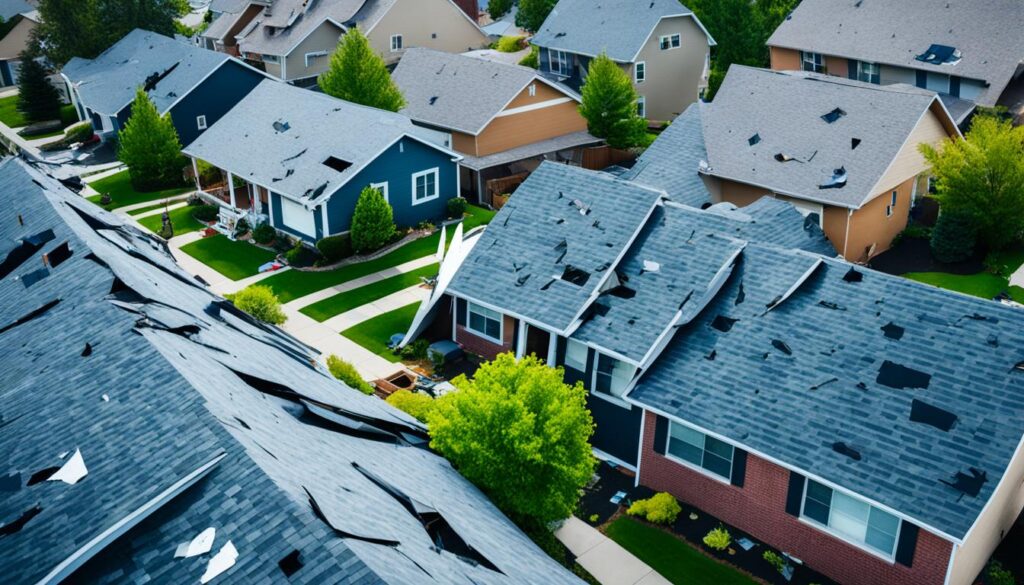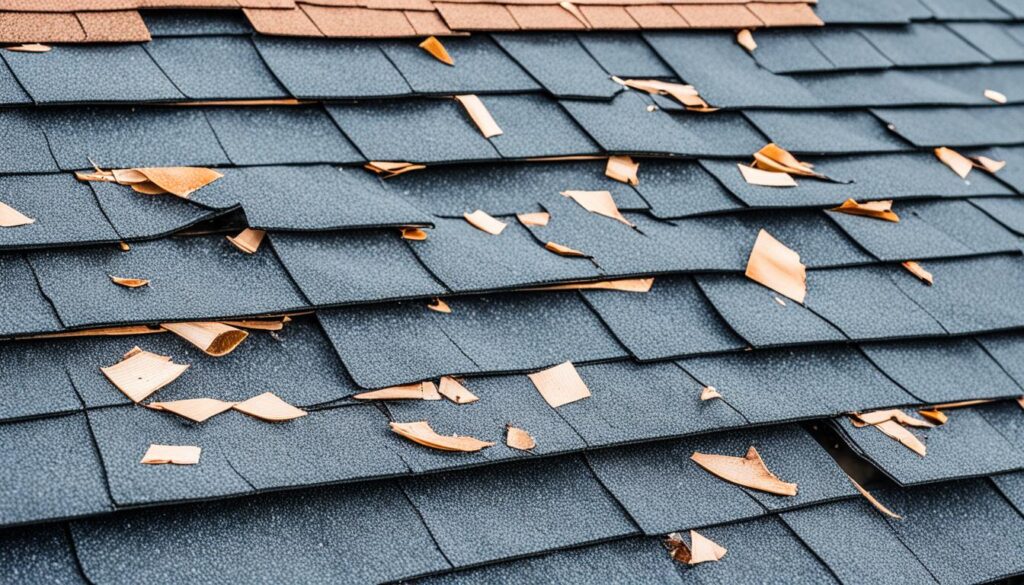Are you aware of the potential costs associated with wind damage to your roof? Not only can it result in expensive repairs or a complete replacement, but it can also leave you facing the daunting task of filing an insurance claim. When it comes to wind damage, do you know what types of damage are covered by homeowners insurance? And how can you ensure you receive the maximum payout from your policy?
According to Forbes Advisor, the cost of a full roof replacement can range from $11,500 to $80,000, depending on the size of the roof and the materials used. With such a significant financial burden at stake, it’s crucial to understand the ins and outs of your insurance coverage to protect your investment.
In this article, we will explore the process of filing an insurance claim for wind damage to your roof and provide valuable tips on maximizing your insurance payout. We will also delve into the types of roof damage covered by homeowners insurance and shed light on the claim process to help you navigate the complexities smoothly.
Key Takeaways:
- Wind damage to your roof can result in costly repairs or a complete replacement.
- It’s important to understand what types of roof damage are covered by homeowners insurance.
- To maximize your insurance payout, follow the proper process when filing a wind damage insurance claim.
- Document the damage, review your insurance policy, and negotiate if necessary.
- By taking the right steps, you can secure the maximum possible payout from your insurance company.
Types of Roof Damage Covered by Homeowners Insurance
When it comes to protecting your home, your roof is one of the most important aspects to consider. Roof damage can be costly to repair or replace, which is why having homeowners insurance is crucial. Understanding what types of roof damage are covered by homeowners insurance can help you prepare for any unexpected expenses.
Types of Roof Damage Covered
- Falling objects: If a tree branch or any other object falls onto your roof, causing damage, homeowners insurance will usually cover the repair or replacement costs.
- Fire: If your roof is damaged due to a fire, whether caused by an electrical issue or another source, homeowners insurance will cover the repairs.
- Hail, lightning, and wind: Damages caused by hail, lightning, and wind are typically covered by homeowners insurance policies. These types of damage can range from missing shingles to more severe structural damage.
- Smoke: If your roof suffers smoke damage due to a fire in your home or nearby, homeowners insurance will generally cover the necessary repairs.
- Weight of ice and snow: In regions prone to heavy snowfall, the weight of ice and snow can cause damage to your roof. Homeowners insurance policies usually cover the repair costs associated with this type of damage.
- Vandalism: If your roof is intentionally damaged by vandals, homeowners insurance will typically cover the repair or replacement costs.
Additionally, if your roof is partially damaged but the lifespan is substantially impacted, your insurance company may cover the cost of replacing the entire roof. This ensures that the repaired section matches the rest of the roof in terms of material and appearance.
It’s important to note that homeowners insurance does not cover all types of roof damage. Damage resulting from lack of maintenance, earthquakes, floods, or normal wear and tear is generally not covered.
Review Your Insurance Policy
To fully understand what types of roof damage are covered by your homeowners insurance policy, it’s crucial to review the policy documents. Each insurance policy is different, and it’s essential to know the specific coverage details and any exclusions.
Filing a Wind Damage Insurance Claim
Dealing with wind damage to your roof can be stressful, but filing an insurance claim can help you recover the costs of repairs. The wind damage insurance claim process involves several important steps:
- Contact your insurance company: Notify your insurance company as soon as possible about the wind damage to your roof. Provide them with all the necessary details, such as the date of the incident and a description of the damage.
- Inspect the damage: An adjuster will be sent by your insurance company to assess the extent of the damage and determine the claim amount. It’s essential to cooperate with the adjuster and provide all necessary evidence, such as photos or videos of the damage.
- Review your insurance policy: Take the time to carefully review your insurance policy to understand what is covered under wind damage. Familiarize yourself with any exclusions or limitations that may affect your claim.
- Protect your home: While waiting for the insurance claim to be processed, it’s crucial to take steps to prevent further damage. Cover any exposed areas with tarps or temporary solutions to mitigate additional issues.
- Hire a contractor: Once your claim is approved, you can hire a reputable contractor to repair the wind damage to your roof. Remember to gather multiple quotes and choose a contractor who is experienced in handling insurance claims.
- Document the repairs: Keep detailed records of all repairs, including invoices, receipts, and any communication with the contractor. This documentation will be important if any issues arise during the claims process.
By following these steps and being thorough in your documentation, you can navigate the wind damage insurance claim process more effectively and increase your chances of receiving a fair settlement.

Wind Damage Insurance Claim Tips
Here are some additional tips to help you through the wind damage insurance claim process:
- Act quickly: Promptly report the damage to your insurance company and begin the claims process as soon as possible.
- Document the damage: Take clear and detailed photos or videos of the wind damage to your roof. This evidence will support your claim and help ensure you receive proper compensation.
- Keep thorough records: Maintain organized records of all communication, including emails, letters, and phone calls, with your insurance company and any contractors involved in the repair process.
- Understand your coverage: Review your insurance policy to understand the specific coverage for wind damage. Be aware of any deductibles or exclusions that may affect your claim.
- Review the claim settlement: Carefully review the claim settlement offered by your insurance company. If you believe the amount is insufficient, consider consulting with a public adjuster or seeking legal advice.
Following these tips can help ensure a smoother wind damage insurance claim process and help you receive the compensation you deserve.
Understanding Roof Damage Claim Process
When it comes to filing a roof damage claim with your insurance company, understanding the process is key. By following the necessary steps, you can ensure a smooth claim experience and maximize your insurance payout.
- Contact your insurance company: The first step is to notify your insurance company of the roof damage. Provide them with all the necessary details, such as the date of the incident and a description of the damage.
- Schedule an inspection: An adjuster will be assigned to assess the extent of the damage. They will inspect your roof for missing or damaged shingles, signs of water damage, and any other issues that may affect the integrity of your roof.
- Document the damage: It’s essential to document the damage with clear photos and videos. This evidence will help support your claim and ensure that all necessary repairs are covered by your insurance.
- File the claim: Once the inspection is complete and you have all the necessary documentation, it’s time to file the claim. Provide your insurance company with all the required information and any supporting evidence you have gathered.
- Hire a contractor: If your claim is approved, you can hire a reputable contractor to repair the roof damage. Make sure to choose a contractor who is experienced in working with insurance claims and can provide a detailed estimate of the repairs.
Throughout the process, it’s crucial to review your insurance policy and understand the coverage you have for roof damage. Factors such as your coverage amount, deductible, and the type of coverage (actual cash value or replacement cost) can impact the amount you receive from your insurance company.
By following these steps and working closely with your insurance company, you can navigate the roof damage claim process successfully and ensure that your roof is restored to its pre-damage condition.
| Step | Description |
|---|---|
| Contact your insurance company | Notify your insurance company of the roof damage and provide necessary details |
| Schedule an inspection | An adjuster will assess the extent of the damage and inspect the roof |
| Document the damage | Take clear photos and videos to support your claim |
| File the claim | Submit the claim with all required information and supporting evidence |
| Hire a contractor | Select a reputable contractor to repair the roof damage |

Conclusion
Filing an insurance claim for wind damage to your roof can be a complex process, but by following the proper steps and understanding your coverage, you can maximize your insurance payout. It’s important to review your insurance policy to know what types of roof damage are covered and what is excluded. Documenting the damage and providing evidence to your insurance company is crucial for a successful claim. Protecting your home from further damage is also important to prevent additional expenses. If your claim is denied or you’re not satisfied with the payout, you can negotiate with your insurance company or hire a public adjuster to help advocate for you. By taking these steps, you can navigate your wind damage insurance claim effectively and secure the maximum possible payout from your policy.

Meet William Adams, a seasoned roofing expert with over 30 years of hands-on experience in the industry. Having worked tirelessly under the scorching sun and through the fiercest storms, William brings a wealth of knowledge and expertise to the table. Hailing from the heart of the USA, he’s witnessed the evolution of roofing practices firsthand, mastering every aspect along the way. Now retired from the field, William spends his days cherishing time with his loved ones while sharing his invaluable insights through this platform. With William at the helm, you can trust that every tip, advice, and recommendation provided is backed by years of real-world experience and unwavering dedication to quality craftsmanship. Join us as we journey through the world of roofing, guided by the wisdom and passion of a true industry veteran.

